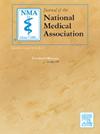Physical activity engagement among Black African-born immigrant women in the United States: Results from the 2011 to 2018 National Health Interview Surveys
IF 2.5
4区 医学
Q1 MEDICINE, GENERAL & INTERNAL
引用次数: 0
Abstract
Introduction
Black women in the US, including Black African immigrant women, have the lowest rates of physical activity (PA). This study aimed to identify sociodemographic, anthropometric, and health characteristics associated with PA engagement among African-born Black women immigrants.
Methods
The sample consisted of 736 Black African-born women respondents the 2011–2018 National Health Interview Surveys. The outcomes of interest were aerobic activity, strengthening activity, and combined aerobic and strengthening activity. Independent variables of interest included sociodemographic characteristics, health behaviors, and anthropometrics. Descriptive statistics and multivariable adjusted logistic regression analyses were performed.
Results and Discussion
Of the 736 women, 43.1 % were sufficiently active in aerobic activities and 17.4 % met the strengthening activity guidelines. Overall, only 15.7 % of the participants met the guidelines for total PA (aerobic and strength), while 55 % did not meet any guidelines. Participants who consumed alcohol were more likely to be sufficiently active in aerobic activity compared to those who abstained (AOR = 3.54, 95 % CI [2.43,5.16]). Factors negatively associated with sufficient aerobic activity were smoking (AOR = 0.42, 95 % CI [0.19,0.92] and having obesity (AOR = 0.50, 95 % CI [0.33,0.75]). The odds of meeting strengthening activity guidelines were greater among those with high school education (AOR = 2.94, 95 % CI [1.20, 7.20]) and more than high school (AOR = 2.54, 95 % CI [1.09,5.95]) than among those with less than high school education, Additionally, being in the US 15 years or more (AOR = 2.15, 95 % CI [1.18–3.91]). and a current drinker (AOR = 2.14, 95 % CI [1.22–3.75]) was positively associated with meeting strength guidelines.
Implications
Findings provide missing information about Black African immigrant women's participation in PA and suggest that more research is needed to understand how African immigrant women make decisions about PA. The findings join calls to disaggregate data and health related research on Africans.
美国非洲裔黑人移民妇女的体育活动参与:2011年至2018年全国健康访谈调查结果
美国黑人女性,包括非洲黑人移民女性,身体活动(PA)率最低。本研究旨在确定非洲出生的黑人女性移民中与PA参与相关的社会人口学、人体测量学和健康特征。方法:样本包括2011-2018年全国健康访谈调查的736名非洲裔黑人女性受访者。感兴趣的结果是有氧运动、强化运动和有氧和强化联合运动。感兴趣的独立变量包括社会人口学特征、健康行为和人体测量学。描述性统计和多变量调整逻辑回归分析。结果和讨论:在736名女性中,43.1% %在有氧运动中足够活跃,17.4% %符合强化运动指南。总体而言,只有15.7 %的参与者符合总PA(有氧和力量)的指导方针,而55 %的参与者不符合任何指导方针。与不饮酒的参与者相比,饮酒的参与者更有可能在有氧运动中表现得足够活跃(AOR = 3.54,95 % CI[2.43,5.16])。与充足的有氧运动负相关的因素是吸烟(AOR = 0.42,95 % CI[0.19,0.92])和肥胖(AOR = 0.50,95 % CI[0.33,0.75])。会议加强活动指南的几率更大的那些高中教育(AOR = 2.94,95 % CI[1.20, 7.20]),超过高中(AOR = 2.54,95 % CI[1.09, 5.95])比那些不到高中教育,另外,在美国15年或更长时间(AOR = 2.15,95 % CI[1.18 - -3.91])。当前饮酒者(AOR = 2.14,95 % CI[1.22-3.75])与符合强度指南呈正相关。启示:研究结果提供了非洲黑人移民妇女参与PA的缺失信息,并建议需要更多的研究来了解非洲移民妇女如何做出PA的决定。这些发现加入了对非洲人的数据和健康相关研究进行分类的呼吁。
本文章由计算机程序翻译,如有差异,请以英文原文为准。
求助全文
约1分钟内获得全文
求助全文
来源期刊
CiteScore
4.80
自引率
3.00%
发文量
139
审稿时长
98 days
期刊介绍:
Journal of the National Medical Association, the official journal of the National Medical Association, is a peer-reviewed publication whose purpose is to address medical care disparities of persons of African descent.
The Journal of the National Medical Association is focused on specialized clinical research activities related to the health problems of African Americans and other minority groups. Special emphasis is placed on the application of medical science to improve the healthcare of underserved populations both in the United States and abroad. The Journal has the following objectives: (1) to expand the base of original peer-reviewed literature and the quality of that research on the topic of minority health; (2) to provide greater dissemination of this research; (3) to offer appropriate and timely recognition of the significant contributions of physicians who serve these populations; and (4) to promote engagement by member and non-member physicians in the overall goals and objectives of the National Medical Association.

 求助内容:
求助内容: 应助结果提醒方式:
应助结果提醒方式:


